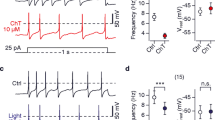Abstract
Silver ions elicit dose-dependently a transient contracture in single fibres of bull-frog toe muscle placed in 0-Ca2+, Cl−-free MOPS solution containing 3 mM Mg2+ and NO −3 . To elucidate the mechanisms involved, changes in membrane potential and in tension development were continuously measured following exposure to Ag+. The effect of Ag+ on contraction in fibres in which the membrane had been depolarized by elevating the external K+ concentration was also examined. The major findings of this investigation are as follows. (1) The mechanical threshold was shifted towards more negative potentials by 5 mV (−51 to −56 mV), when Ca2+ and Cl− in the Ringer's solution were replaced with Mg2+ and NO −3 , respectively. (2) On the exposure of the fibres to 5 μM Ag+, the membrane potential decreased by 1.6 mV from −87.8 mV and tension was developed. (3) In fibres soaked in a solution containing 10 mM K+ (corresponding to a membrane potential of −69.5 mV), 5 μM Ag+ produced a large contracture similar to that seen in the control solution. (4) The Ag+-induced contracture was inactivated when more than 20 mM K+ was used. (5) The membrane depolarization evoked by either 20 or 50 μM Hg2+ did not produce contraction. (6) Muscle fibres which had been exposed to 20 μM Hg2+ for 5 min responded to 5 μM Ag+ by a transient tension development. These findings strongly suggest that Ag+-induced tension development is not associated with depolarization of the surface membrane but rather is caused by specific actions of Ag+ on membrane proteins in the T-tubules.
Similar content being viewed by others
References
Abramson JJ, Trimm JL, Weden L, Salama G (1983) Heavy metals induce rapid calcium release from sarcoplasmic reticulum vesicles isolated from skeletal muscle. Proc Natl Acad Sci USA 80:1526–1530
Aoki T, Oba T, Hotta K (1985) Hg2+-induced contracture in mechanically skinned fibers of frog skeletal muscle. Can J Physiol Pharmacol (in press)
Bindoli A, Fleischer S (1983) Induced Ca2+ release in skeletal muscle sarcoplasmic reticulum by sulfhydryl reagents and chlorpromazine. Arch Biochem Biophys 221:458–466
Chang CC, Lu SE, Wang PN, Chuang ST (1970) A comparison of the effects of various sulfhydryl reagents on neuromuscular transmission. Europ J Pharmacol 11:195–203
Cota G, Stefani E (1982) External calcium and contractile activation during potassium contractures in twitch muscle fibres of the frog. Can J Physiol Pharmacol 60:513–523
Endo M (1977) Calcium release from the sarcoplasmic reticulum. Physiol Rev 57:71–108
Frankenhaeuser B, Lännergren J (1967) The effect of calcium on the mechanical response of single twitch muscle fibres of Xenopus laevis. Acta Physiol Scand 69:242–254
Hodgkin AL, Horowicz P (1960) Potassium contractures in single muscle fibres. J Physiol (Lond) 153:386–403
Juang MS (1976) An electrophysiological study of the action of methylmercuric chloride and mercuric chloride on the sciatic nerve-sartorius muscle preparation of the frog. Toxicol Appl Pharmacol 37:339–348
Lüttgau HC, Spiecker W (1979) The effects of calcium deprivation upon mechanical and electrophysiological parameters in skeletal muscle fibres of the frog. J Physiol (Lond) 296:411–429
Martonosi A, Feretos R (1964) Sarcoplasmic reticulum. I. The uptake of Ca2+ by sarcoplasmic reticulum fragments. J Biol Chem 239:648–658
Miyamoto MD (1983) Hg2+ causes neurotoxicity at an intracellular site following entry through Na and Ca channels. Brain Res 267:375–379
Nagai T, Takauji M, Kosaka I, Tsutsu-ura M (1979) Biphasic time course of inactivation of potassium contractures in single twitch muscle fibers of the frog. Jpn J Physiol 29:539–549
Oba T, Hotta K (1983) The effect of changing free Ca2+ on light diffraction intensity and correlation with tension development in skinned fibers of frog skeletal muscle. Pflügers Arch 397:243–247
Oba T, Hotta K (1984) Silver ion induces transient tension development in Ca2+-channel blocked skeletal muscle fibers. Jpn J Physiol 34:187–191
Oba T, Yamamoto M, Aoki T, Hotta K (1983) Mechanical, electrical and morphological characteristics of skeletal muscle fibers fromXenopus and other species of frogs. Jpn J Physiol 33:521–534
Salama G, Abramson J (1984) Silver ions trigger Ca2+ release by acting at the apparent physiological release site in sarcoplasmic reticulum. J Biol Chem 259:13363–13369
Sandow A, Taylor SR, Preiser H (1965) Role of the action potential in excitation-contraction coupling. Fed Proc 24:1116–1123
Schneider MF (1981) Membrane charge movement and depolarization-contraction coupling. Annu Rev Physiol 43:507–517
Schneider MF, Chandler WK (1973) Voltage dependent charge movement in skeletal muscle: a possible role in excitationcontraction coupling. Nature (Lond) 242:244–246
Taylor SR, Preiser H, Sandow A (1969) Mechanical threshold as a factor in excitation-contraction coupling. J Gen Physiol 54:352–368
Author information
Authors and Affiliations
Rights and permissions
About this article
Cite this article
Oba, T., Hotta, K. Silver ion-induced tension development and membrane depolarization in frog skeletal muscle fibres. Pflugers Arch. 405, 354–359 (1985). https://doi.org/10.1007/BF00595688
Received:
Accepted:
Issue Date:
DOI: https://doi.org/10.1007/BF00595688




